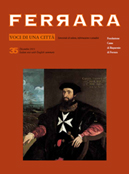From the eighties to the present: culture, commerce, technology, and more in the stands of the "Fiera"
 The approach to our Exhibition Centre follows a somewhat particular route, the road from Ferrara has no houses and few large buildings and the Centre is located on a strip of road that leads to a sort of city terminus. With this premise it would be difficult to predict a success story, and yet ...
The approach to our Exhibition Centre follows a somewhat particular route, the road from Ferrara has no houses and few large buildings and the Centre is located on a strip of road that leads to a sort of city terminus. With this premise it would be difficult to predict a success story, and yet ...
The Exhibition Centre, well-designed by Gregotti and built in the mid-eighties, covers sixteen thousand square meters. What is the most important task that the Centre has to perform? Without doubt it is a sharp acceleration with regard to the meeting of supply and demand. The commercial branch of each industrial sector benefits enormously from the establishment of this market; industrialised areas need a place of commercial visibility - the Exhibition Centre - which increases the importance of the manufacturing district. Ferrara does not have an industrial district and the main source of employment is agriculture, which generated an important idea in the sixties with the Eurofrut exhibition. If we had invested more in this initiative in the past, today we would probably be fruit sector exhibition leaders. Therefore, with no real territorial vocation, the progress of our Exhibition Centre has been by trial and error, but with two fortunate meetings: the Restoration exposition and the Accadueo-H2O event, which dealt with important water-related issues. However, we must reflect on a couple of considerations: the Internet and shopping malls.  The first tends to cancel the exhibitive aspect, whilst the latter takes away the charm and attractiveness of trade-fairs, as they themselves are centres of display.
The first tends to cancel the exhibitive aspect, whilst the latter takes away the charm and attractiveness of trade-fairs, as they themselves are centres of display.
So what can be done? Does this foretell an early death of this industry? No, because a virtual proposal is not a signed business deal, subsequently the need to meet remains. The exhibition centre thus becomes a place that interprets its own industrial sector, amalgamating the community of operators and creating industrial culture that brings together research, University and Public Administration in a single unit, at the hub of the business world and fully prepared to participate and compete in today's global market. Events related to leisure and entertainment activities must cater for enthusiastic users, creating monothematic exhibitions for the hobby sector. I should cite ICT TRADE, which has produced ten editions of computer and telecommunication technology events; REMTECH - the exhibition on the remediation of contaminated sites. The entertainment sector is represented by events for vintage cars and motorcycles,  not to mention Airsoft, historical re-enactments, festivals and Balloons, a magnificent celebration of hot-air balloons, held in the city park. An excellent calendar, two million Euros in revenues, a balanced budget, twenty-five conferences conducted in the multipurpose room, over one hundred and twenty thousand visitors a year, twelve employees and consultants, two thousand guests for local hotels, an abundance of ideas and the hope that the crisis won't stop us when we are at our best.
not to mention Airsoft, historical re-enactments, festivals and Balloons, a magnificent celebration of hot-air balloons, held in the city park. An excellent calendar, two million Euros in revenues, a balanced budget, twenty-five conferences conducted in the multipurpose room, over one hundred and twenty thousand visitors a year, twelve employees and consultants, two thousand guests for local hotels, an abundance of ideas and the hope that the crisis won't stop us when we are at our best.








